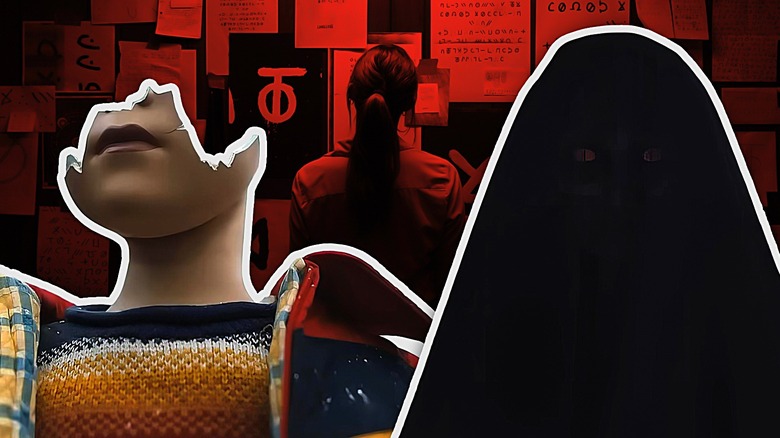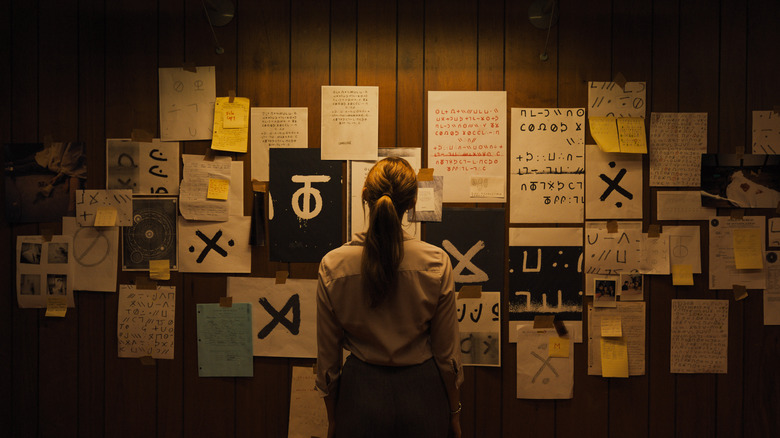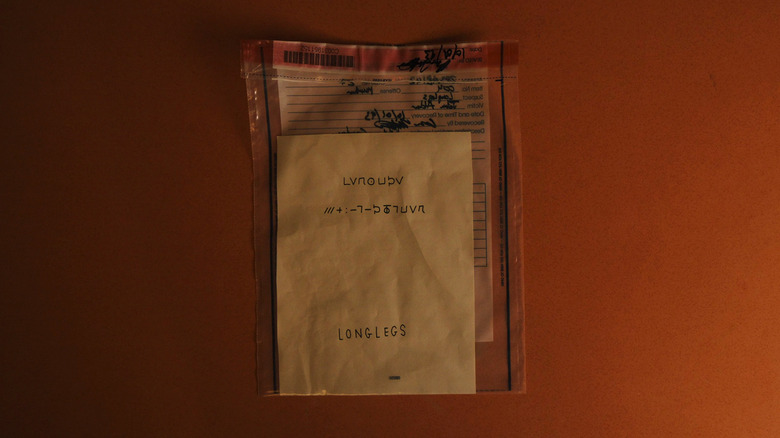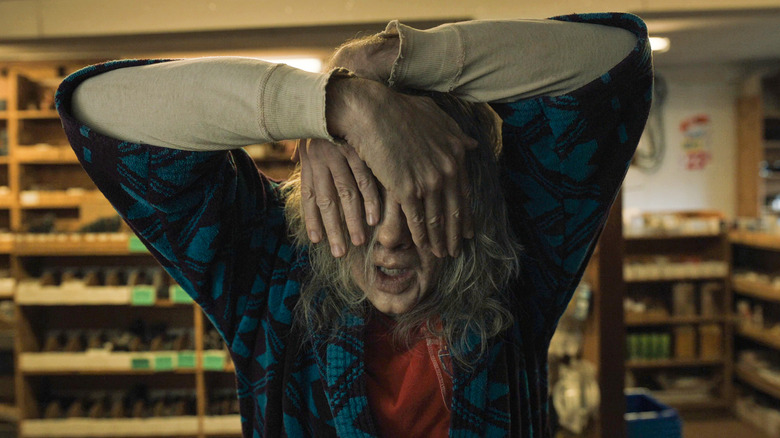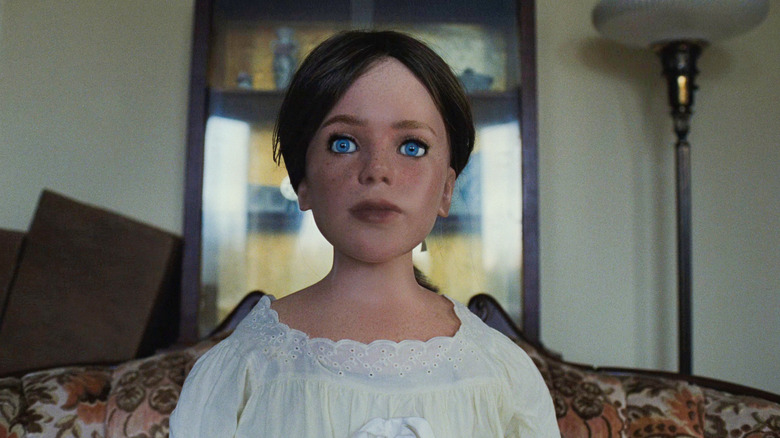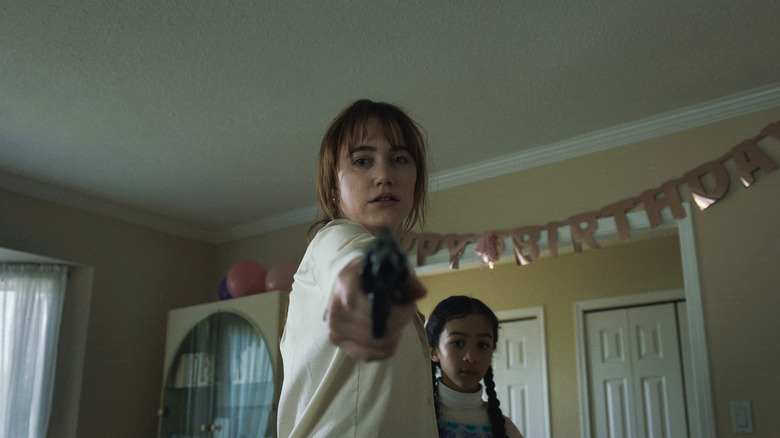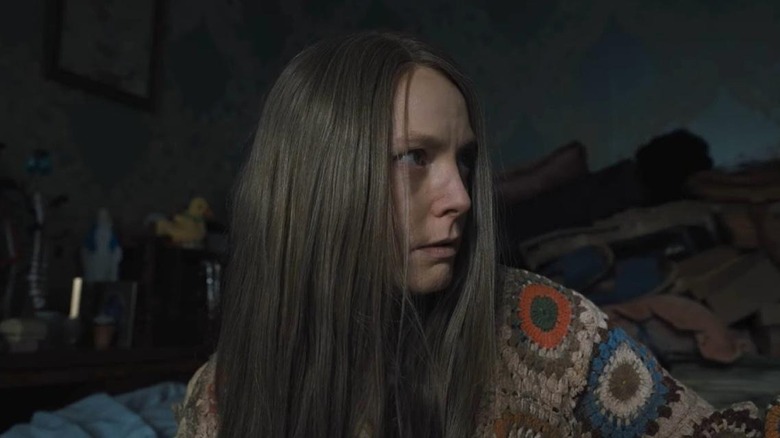The Most Confusing Parts Of Longlegs, Explained
We may receive a commission on purchases made from links.
This post contains spoilers for "Longlegs."
So, you finally dared to watch the most terrifying horror movie of the year, "Longlegs." Despite the fact the film wraps up its central mystery quite neatly by the end, you likely have some questions about director Osgood Perkins' nightmarish supernatural serial killer tale. Who exactly was Longlegs before he was co-opted by the devil? Why is he called Longlegs? Was the devil just behind everything the whole time?
These questions and more will be answered here, as we delve into the nitty gritty of this certified horror hit. "Longlegs" quickly became horror's biggest box office surprise of the year, making an incredible $22 million in its opening weekend (its highest projection prior to that was $15 million), and dropping just 48% in its second weekend. That might not seem all that impressive, but this is a huge debut for a horror movie, no doubt propelled by what was a masterclass in horror marketing by "Longlegs" distributor Neon.
Considering more people are watching this movie than frankly anyone expected, questions about the finer points of "Longlegs" are likely widespread. What's more, there are a lot more hidden details in Oz Perkins' horror hit than you might have realized on first viewing. Which is exactly why we've put together this helpful guide. Allow us, then, to crack the cipher that is "Longlegs" with a breakdown of the most confusing parts in the film.
What's the plot of Longlegs, and what happens in the ending?
At the beginning of the film, Longlegs (Nicolas Cage) visits a young Lee Harker (Lauren Acala) at her home. Though we don't see much of the mystery man at this point, he's quite clearly deranged (in about as Nicolas Cage a way as possible). Ultimately, we learn that Longlegs was a doll-maker who came under the devil's sway and was forced to build mannequins with the spirit of Lucifer somehow imbued into small chrome orbs inside their heads. Longlegs would then visit girls around their ninth birthdays, delivering the ungodly dolls and the devil contained therein to their homes. Once inside, the dolls would possess the fathers and compel them to murder their families.
But in order to get the dolls inside the homes, Longlegs needed an accomplice. After all, a pallid, disheveled creeper with a penchant for screeching esoteric '70s rock at the top of his lungs doesn't exactly seem like the greatest hang. As it turns out, when Longlegs initially visited the Harker home, he recruited Lee's mother, Ruth (Alicia Witt), who, in exchange for her daughter's life, agreed to dress as a nun and deliver the dolls as gifts from the church to the homes of unsuspecting families.
By the end of the film, an adult Lee Harker (Maika Monroe) discovers that Longlegs was living in the basement of her childhood home the entire time — hence the moniker "the man downstairs." The film ends with Harker's boss, Agent Carter (Blair Underwood), becoming the final target of Lucifer's plan. When Ruth delivers a doll to the home, Carter kills his wife before Lee shoots him. Ruth then tries to intervene and kill Carter's daughter, forcing Lee to shoot her own mother dead, bringing the devil's entire plan to its horrifying conclusion.
Who is Longlegs, and why does he look like that?
Even after "Longlegs" wraps up, the serial killer himself remains one of the biggest mysteries in the film. Despite the fact that Nicolas Cage's disturbed doll-maker is at the center of the FBI investigation, we don't actually learn a whole lot about him beyond the fact he was forced to do the devil's bidding by building some of the creepiest-looking dolls you've ever seen. But as far as the character's background prior to becoming Satan's stooge? We largely remain as clueless as the FBI during the early stages of their investigation.
There is somewhat of a backstory for Longlegs, much of which is conveyed visually. As director Oz Perkins told Total Film, the script actually refers to him as someone who's been "ruined by living the life that he's had to live." In other words, Longlegs was just a regular dude prior to his encounter with the dark lord. Perkins elaborated further in an IndieWire interview, where he said, "The idea was that he'd been busted by sh***y plastic surgery."
So, Longlegs is a walking cosmetic surgery mishap. But there's more. As makeup department head Felix Fox told Indiewire, "It's very much glam rock inspired. If you catch a full glimpse on screen, he's got his lizard white leather cowboy boots." And Perkins confirmed that Longlegs' white makeup was inspired by Bob Dylan and his "Rolling Thunder Revue" era, telling IndieWire the makeup is "this weird sort of performative thing."
In that sense, Longlegs can be seen as a former glam rocker, intent on preserving his youth through surgery, who wound up finding Satanism and eventually crossing paths with the devil himself. In fact, Neon recently released a video of "the last known musical recording by Dale Ferdinand Kobble [Cage's character's real name in the film] before the voices took over," which gives you a sense of what the character was like before the events of the movie unfold:
Why the name Longlegs?
Prior to the film's release, trailers contained a shot of a girl's body covered by a sheet, her unusually long legs protruding from under the bloodied cloth. This, I thought, would be the key to the name. Alas, after seeing the film, not only does this bleak tableau have nothing to do with the term "Longlegs," it's never explicitly relayed how the killer got his name.
When he first introduces himself to an eight-year-old Lee Harker, Longlegs delivers the chilling line, "I have my long legs on today," referring to the fact he needs to bend down to speak to her. But beyond that brief mention, the phrase "Longlegs" itself is never fully explained.
When asked about it, Oz Perkins remained non-committal, telling Variety:
"We writers just like words. We like how certain words sound and look and shape and feel [...] it also feels '70s to me — almost like a Led Zeppelin song or someone would have on the side of their van, something groovy like that. It feels like a vintage word that people wouldn't toss around much today."
There is, of course, the obvious "daddy long-legs" connotation. Fatherhood, and parenthood generally, is a central theme in this movie. The fathers are all forced to kill their families, and Longlegs creates child-like dolls which he treats as though they were real children, combing their hair and fussing over them in a grim parody of real fatherhood. We also never see nor hear about Harker's own father, and Longlegs almost comes to represent a perverse step-father, living in the same house as Harker and her mother and forming a twisted partnership with Ruth before ultimately steering Lee towards the answers she seeks. Beyond that, the name remains as much a mystery as the man himself.
Why does Longlegs say 'cuckoo'?
The very first scene of the film, in which a young Lee Harker encounters Longlegs at her home for the first time, is relatively quiet until we hear Nic Cage's killer whisper "cuckoo." It's a term that returns throughout the film, with Longlegs performing some sort of cuckoo-clock inspired maneuver during his visit to the local grocery store later in the movie. But what does a cuckoo have to do with anything?
Some theories have posited that the cuckoo call represents the real-life behavior of cuckoo birds. Known as "obligate brood parasites," cuckoos actually lay eggs in other birds' nests. The hatched babies then either push the original eggs out of the nest or hatch alongside them only to be raised by the host bird. This is somewhat reminiscent of how Longlegs not only invades Harker home, but of the way in which his dolls invade the homes of other children. It is, however, just a theory.
What seems more likely is that the cuckoo call comes from Cage's own personal experience. The actor revealed during an interview that he modeled parts of Longlegs on his own mother, Joy Vogelsang:
"When I was reading this character it became about my mom. I heard her voice. She wasn't satanic, but she went through a lot and I heard her voice and the way she would move, and suddenly I thought, 'You know, I could put all that into this character."
According to Oz Perkins, this is the real origin of the cuckoo call. USA Today reported that Cage patterned Longlegs' "hand movements, higher-pitched voice and penchant for saying 'cuckoo'" on his mother. Perkins told the outlet, "She did a lot of things to freak him out. He harvested a lot of memory of his mom."
Why does Longlegs kill girls with birthdays on the 14th?
As Lee Harker delves deeper into the serial killings, she focuses on how the families involved all have a daughter with a birthday on the 14th of the month. The murder-suicides all happen within six days on either side of that date. Harker uncovers the significance of the 14th by writing out the days of each month in a line across a page, then marking the dates each family was killed. She then discovers that the dates in question all form an inverted triangle — a sign of the devil.
It seems, then, that Longlegs was carrying out his murder suicide plots in such a way so as to please his master, Satan. What's more, the fact that he plans these attacks close to the girls' birthdays give his accomplice, Ruth, an excuse to deliver the dolls to the homes in the first place. Happy birthday!
The 14th also has biblical significance, especially considering the quote from the book of Revelation which appears throughout the film: "And I saw a beast rise out of the sea, having seven heads and ten horns, and upon his horns ten crowns, and upon his head the name of blasphemy." The verse itself is Revelation 13:1. Add the chapter and verse numbers together, and what do you get?
Of course, the fact that Harker figures all this out and tells her boss, Agent Carter, about it makes Carter himself look pretty foolish for an FBI agent. His own daughter's birthday is revealed to fall on the 14th early in the film, and you'd think Carter would have been at least a tad concerned about his family's welfare upon hearing that Longlegs has a penchant for wiping out families with daughters whose birthdays are on that date.
Why does Ruth shoot the doll in the head?
From the beginning of "Longlegs," we see Lee Harker demonstrating what appear to be psychic abilities. She's somehow able to guess which house a suspect is hiding in during a canvassing trip with her FBI colleague, and after taking the Bureau's psychic evaluation, she manages to get half the answers right, leading Agent Carter to refer to his subordinate as "half-psychic."
Later, we learn the source of this extra-sensory ability. It turns out that when Longlegs first visited the Harker house, he brought a doll modeled on Lee. Ever since the killer agreed to spare Lee's life, her mother Ruth has kept the doll at home. Towards the climax of the film, we see an adult Lee run out of her house to witness her mother shooting the doll, releasing a cloud of black smoke from the doll's head, which is also shown rising from Lee's own head before she collapses.
The implication here is that Lee's psychic abilities all stem from the doll. Throughout the FBI investigation, Harker has been one step ahead of the Bureau, and it seems her connection to the doll is the explanation. What's more, it's suggested that the doll, with its Satanic spirit, has stopped Lee from remembering certain aspects of her life, so as to prevent her from realizing what her mother was doing and that Longlegs himself was living at the family home.
One question this raises, however, is that if the doll's Satanic influence can be undone by blasting it with a shotgun, why didn't Ruth Harker simply destroy it earlier? As with so much of this film, the explanation appears to be: The devil made her do it.
Did I see the devil hiding in the background?
A clip from Neon's official YouTube account compiles several shots from "Longlegs" featuring the devil hiding in the background. The description for the video reveals that, "Writer-director Osgood Perkins has hidden more than 15 appearances of the devil" in the film, so if you're as perceptive as Lee Harker herself, you may well have spotted old Beelzebub. But why?
Of course, aside from the fact it's really cool, the devil is revealed to be behind everything that transpires in "Longlegs." The serial killer himself is not the big bad in this wretched tale, but merely a servant of the dark lord. As is revealed in the final minutes of the film, the devil recruited Longlegs to carry out his unspeakable plan, using his skills as a doll-maker to sneak his essence into the homes of unsuspecting families, before possessing the fathers and forcing them to kill their loved ones.
But the most torturous element of the devil's plan was seemingly reserved for Lee Harker herself, who not only discovers her mother was Longlegs' accomplice and that the serial killer was living in the basement of her childhood home the entire time, but is forced to shoot her boss and own mother in the film's finale, surely traumatizing the harried FBI agent for life. All of this was the work of the devil, who might have spared Harker's life initially, but has since been carrying out his awful plan all with the goal of completely decimating Harker's life by the end of "Longlegs." As such, hiding Satan in the background of multiple shots only enhances this sense of the grand plan not only being orchestrated by him, but that he's watching and waiting for his abomination of a finale to occur.
If the devil is everywhere, why the doll plot?
If the devil can be anywhere he chooses and is watching the whole story play out from various vantage points throughout "Longlegs," doesn't this raise the question of why the devil needed to be smuggled into houses inside ominous dolls? Yes. But the explanation would surely have something to do with the idea that Satan was merely doing this for fun. He wanted to force Longlegs and Ruth Harker to carry out these horrific acts. He enjoyed twisting Longlegs' doll-making skills into some obscene parody of craftsmanship. He reveled in slowly unraveling Lee Harker's life over the years. The whole thing, then, was just some sick, sadistic project. As Oz Perkins explained it to Variety:
"It's part of the playfulness of the devil. Wouldn't it be kind of amazing if you brought a doll into someone's house and it made everybody crazy. That's sort of funny and weird. It's almost like, 'You f****d up and let him in. You didn't have to sign for that! Just because a nun brings it in to you, doesn't mean you should let her into your place with it.' There is also that kind of 'you did it to yourself' vibe, which I think is sort of fun."
This also ties into the sense that "Longlegs" is about families bringing harm and tragedy upon themselves. Perkins has spoken about the film relating to his own experiences growing up. By having the devil play out a plan that involves families willingly inviting the devil dolls inside their homes, Perkins is sketching out a metaphor for families unwittingly allowing nefarious and harmful elements into their lives even while they might have the best intentions, making for one of the scariest serial killer movies in the process.
You can hear two of /Film's editors have a spoiler-filled conversation about the movie on this episode of the /Film Daily podcast:
Why couldn't Lee shoot the doll during the ending of Longlegs?
The final moments of "Longlegs" see Lee Harker forced to shoot her boss and her own mother to save Ruby Carter (Ava Kelders). After doing so, Harker turns the gun on the possessed doll that was brought to Carter's home by Ruth Harker, but is unable to shoot it. The moment is most easily understood as a way of conveying the idea that evil is always lurking and never fully defeated. But on a more practical level, the question of why Harker didn't, or couldn't, shoot the doll remains.
Previously, we saw Ruth shoot the doll that represented her daughter, and the FBI forensic team were able to remove the chrome ball inside a doll's head, so we know these things aren't some invincible symbols of the dark lord, protected by black magic. Lee does attempt to pull the trigger several times, but is met with only a quiet clicking noise. It's unclear whether she's being held back from completing the action, or whether the gun itself has jammed as a result of the dark energy contained in the doll influencing events in the room. Either way, it seems Oz Perkins was really just trying to emphasize the fact that the devil's plan has led to Harker becoming fully subsumed by the darkness, having shot her own mother in a grim coup de grace for the devil. Making the gun jam allows for a moment where the weight of it all settles in, and the demonic doll — a symbol of Satan's presence — is all that remains. As Perkins told Variety:
"That was always the ending. The ending was meant to be tragic. The devil wins again on a small scale. One of the fun things about using the devil as your villain is that the devil never really goes for world domination. The devil always feels like, 'I'll just f**k with this person, I'll wreck this family, I'll mess this kid up, I'll torment this priest.' It's never like, 'I'm going to eat the Vatican.' [...] The story of Lee Harker ends with the ending of the movie. The last shot that she fires is the worst thing that can happen to her."
Having the gun jam, then, really just serves as a way to reinforce this idea: that the worst has already happened. Whether Harker shoots the doll or not, the devil has already won.
What is the meaning behind Longlegs?
To understand "Longlegs," you need to know a little more about Oz Perkins himself. In case his last name didn't already tip you off, he is indeed the son of Anthony Perkins, the late actor who famously played Norman Bates in Alfred Hitchcock's "Psycho." Anthony Perkins was also a gay man who underwent conversion therapy — a horrible and abusive pseudo-scientific practice whose proponents claim it can "cure" members of the LGBTQ+ community (a procedure that's still legal in a depressing number of places in the U.S.) — prior to marrying Oz Perkins' mother, model/actor Berry Berenson. Oz Perkins himself has talked about all this on multiple occasions, including in the Shudder docuseries "Queer for Fear: The History of Queer Horror."
"Longlegs" is, at its core, a horror story about the extremes parents will go to in order to protect their children and, in doing so, the effects that can have on their relationship to one another. It doesn't take a leap to draw a line between this theme and Oz Perkins' experiences growing up, in which Berenson (who was killed in the September 11, 2001 terrorist attacks) constantly lied to him and his brother, musician Elvis Perkins, about their father's sexuality. Meanwhile, Anthony Perkins (who died from AIDS-related complications in 1992) felt the need to subject himself to terrible mistreatment and was forced to spend his entire life living a lie simply so he could be allowed to have a family (a basic privilege afforded to anyone and everyone who's cisgender and heterosexual).
Speaking to IndieWire, Oz Perkins acknowledged that the darkness in his personal life inevitably manifests itself in all of his work, but especially in "Longlegs." "[...] As coded as it might be and as many layers of other stuff on it that there are, at the end of the day, all the movies I generate are essentially based on my experience, and that tends to be my experience with my parents," as he put it.
In a separate interview with The Hollywood Reporter, Perkins noted that "Longlegs" represents his most personal film to date in that regard:
"I try not to tell my children any protective lies, having grown up in a family where certain truths were curated, not maliciously and with any kind of cruelty or dismissiveness, but rather as a move to sustain the family and keep things together. So, the idea that a mom, in this case, can create a story, a lie, a narrative, a version and dress their children in it like a hazmat suit, is definitely where ['Longlegs'] came from. That's the kernel of truth that started the process."
